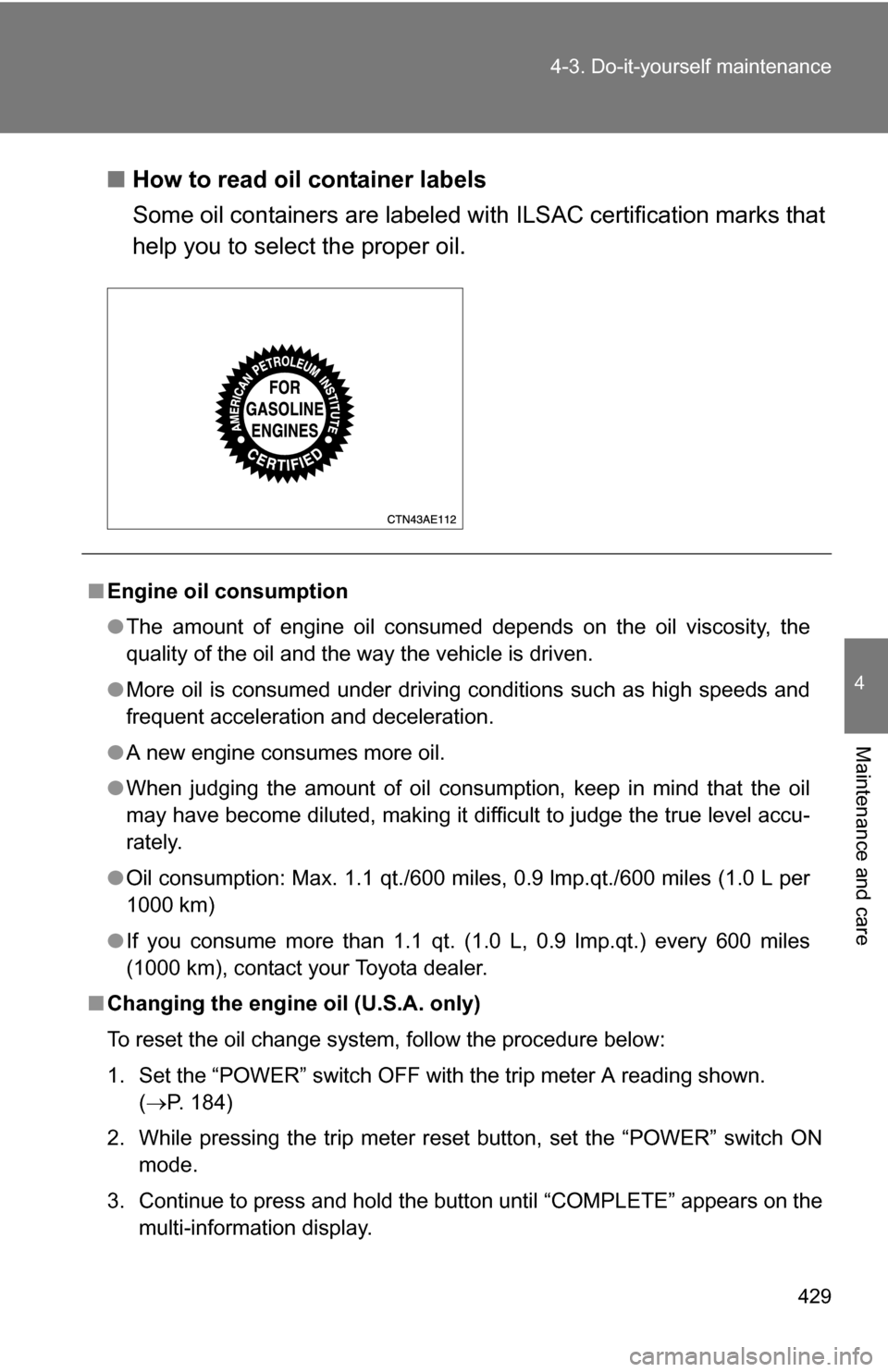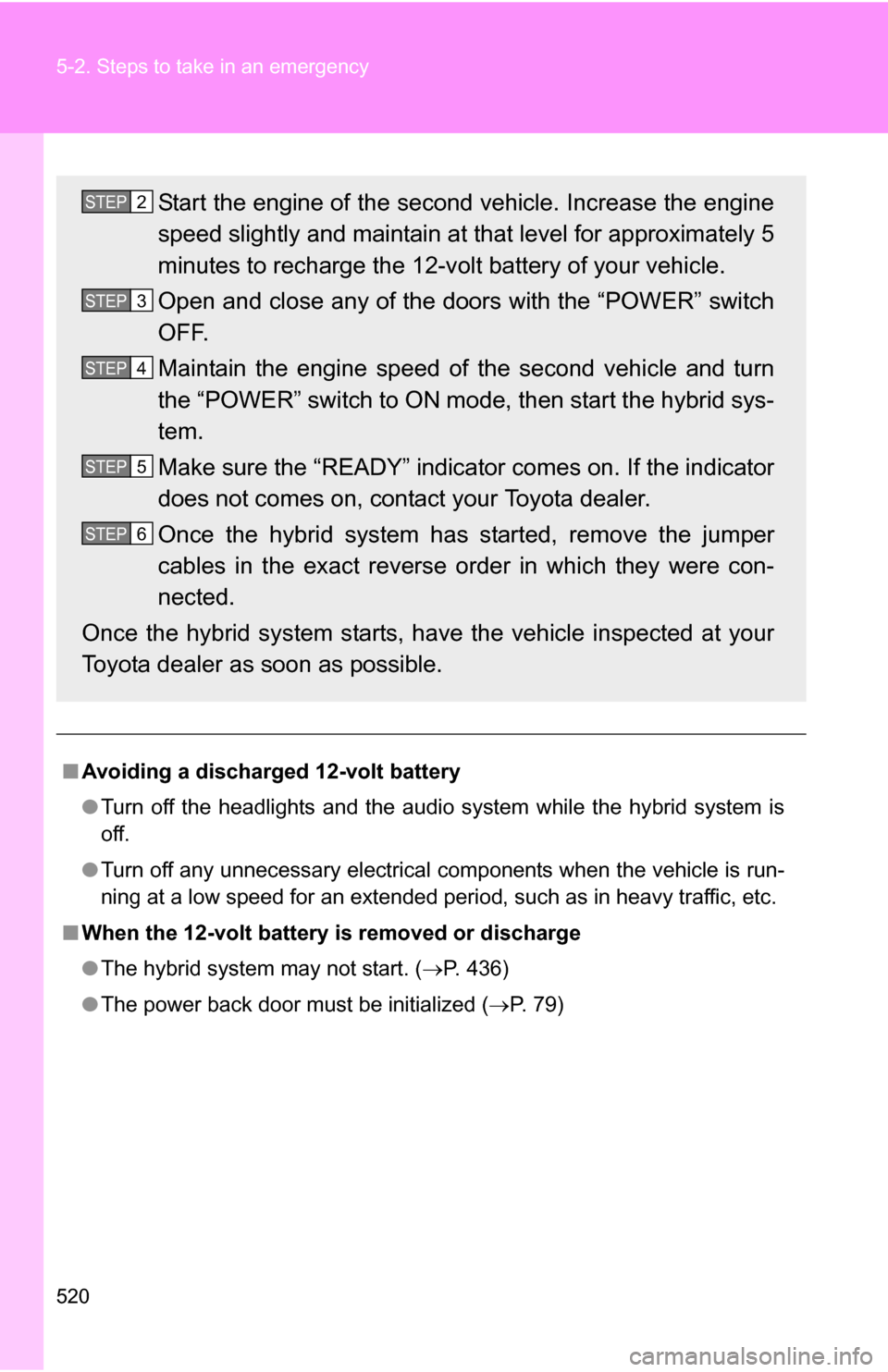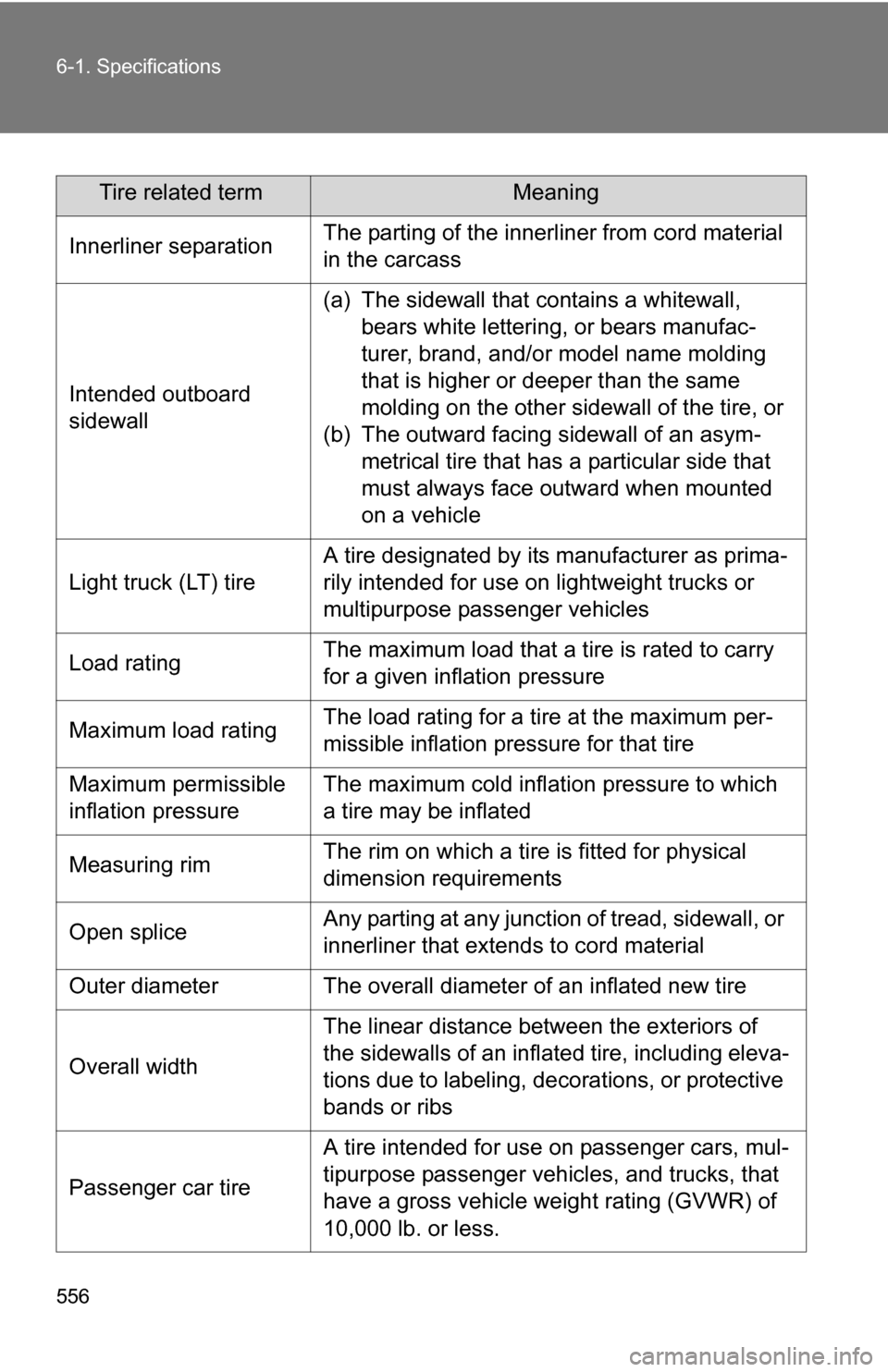Page 429 of 580

429
4-3. Do-it-yourself maintenance
4
Maintenance and care
■
How to read oil container labels
Some oil containers are labeled with ILSAC certification marks that
help you to select the proper oil.
■Engine oil consumption
●The amount of engine oil consumed depends on the oil viscosity, the
quality of the oil and the way the vehicle is driven.
● More oil is consumed under driving conditions such as high speeds and
frequent acceleration and deceleration.
● A new engine consumes more oil.
● When judging the amount of oil consumption, keep in mind that the oil
may have become diluted, making it difficult to judge the true level accu-
rately.
● Oil consumption: Max. 1.1 qt./600 miles, 0.9 lmp.qt./600 miles (1.0 L per
1000 km)
● If you consume more than 1.1 qt. (1.0 L, 0.9 lmp.qt.) every 600 miles
(1000 km), contact your Toyota dealer.
■ Changing the engine oil (U.S.A. only)
To reset the oil change system, follow the procedure below:
1. Set the “POWER” switch OFF with the trip meter A reading shown.
(P. 184)
2. While pressing the trip meter reset button, set the “POWER” switch ON mode.
3. Continue to press and hold the button until “COMPLETE” appears on the multi-information display.
Page 445 of 580
445
4-3. Do-it-yourself maintenance
4
Maintenance and care
CAUTION
■When inspecting or replacing tires
Observe the following precautions to
prevent accidents. Failure to do so
may cause damage to parts of the drive train, as well as dangerous han-
dling characteristics, which may le ad to fatal or injury accidents.
●Do not mix tires of different makes, models, tread patterns or tread-
wear.
●Do not use tire sizes other than those recommended by Toyota.
●Do not mix radial, bias-belted, or bias-ply tires.
●Do not mix summer, all season and winter tires.
●Do not use tires that have been used on another vehicle.
●Do not use tires if you do not know how they were used previously.
●Do not tow the vehicle with the spare tire installed.
Page 514 of 580
514 5-2. Steps to take in an emergency
Emergency start functionWhen the hybrid system does not start, the following steps can be
use as an interim measure to start the hybrid system if the “POWER”
switch is functioning normally.
Set the parking brake.
Shift the shift lever to P.
Turn the “POWER” switch to the ACCESSORY mode.
Push and hold the “POWER” switch about 15 seconds while
depressing the brake pedal firmly.
Even if the hybrid system can be started using the above steps, the
system may be malfunctioning. Ha ve the vehicle checked by your
Toyota dealer.
■ The interior lights and headlights do not turn on, or the horn
does not sound.
One of the following may be the cause of the problem.
●One or both of the 12-volt ba ttery terminals may be discon-
nected.
● The 12-volt battery may be discharged. ( P. 519)
Contact your Toyota dealer if the problem cannot be repaired, or if
repair procedures are unknown.
STEP1
STEP2
STEP3
STEP4
Page 518 of 580
518 5-2. Steps to take in an emergency
To change “POWER” switch modes: Within 5 seconds of the
buzzer sounding, release the brake pedal and press the
“POWER” switch. Modes can be changed each time the
switch is pressed. ( P. 175)
To start the hybrid system: Press the “POWER” switch within
5 seconds after the buzzer sounds, keeping the brake pedal
depressed.
In the event that the hybrid system still cannot be operated, contact
your Toyota dealer.
■ Stopping the hybrid system
Shift the shift lever to P and press the “POWER” switch as you normally do
when stopping the hybrid system.
■ Replacing the key battery
As the above procedure is the temporary measure, it is recommended that
the electronic key battery be replaced immediately when the battery
depletes. ( P. 456)
STEP3
Page 520 of 580

520 5-2. Steps to take in an emergency
■Avoiding a discharged 12-volt battery
●Turn off the headlights and the audio system while the hybrid system is
off.
● Turn off any unnecessary electrical components when the vehicle is run-
ning at a low speed for an extended period, such as in heavy traffic, etc.
■ When the 12-volt battery is removed or discharge
●The hybrid system may not start. ( P. 436)
● The power back door must be initialized ( P. 7 9 )
Start the engine of the second vehicle. Increase the engine
speed slightly and maintain at that level for approximately 5
minutes to recharge the 12-v olt battery of your vehicle.
Open and close any of the doors with the “POWER” switch
OFF.
Maintain the engine speed of the second vehicle and turn
the “POWER” switch to ON mode, then start the hybrid sys-
tem.
Make sure the “READY” indicator comes on. If the indicator
does not comes on, contact your Toyota dealer.
Once the hybrid system has started, remove the jumper
cables in the exact reverse order in which they were con-
nected.
Once the hybrid system starts, ha ve the vehicle inspected at your
Toyota dealer as soon as possible.STEP2
STEP3
STEP4
STEP5
STEP6
Page 556 of 580

556 6-1. Specifications
Tire related termMeaning
Innerliner separation The parting of the innerliner from cord material
in the carcass
Intended outboard
sidewall (a) The sidewall that contains a whitewall,
bears white lettering, or bears manufac-
turer, brand, and/or model name molding
that is higher or deeper than the same
molding on the other sidewall of the tire, or
(b) The outward facing sidewall of an asym- metrical tire that has a particular side that
must always face outward when mounted
on a vehicle
Light truck (LT) tire A tire designated by its manufacturer as prima-
rily intended for use on lightweight trucks or
multipurpose passenger vehicles
Load rating The maximum load that a tire is rated to carry
for a given inflation pressure
Maximum load rating The load rating for a tire at the maximum per-
missible inflation pressure for that tire
Maximum permissible
inflation pressure The maximum cold inflation pressure to which
a tire may be inflated
Measuring rim The rim on which a tire is fitted for physical
dimension requirements
Open splice Any parting at any junction of tread, sidewall, or
innerliner that extends to cord material
Outer diameter The overall diameter of an inflated new tire
Overall width The linear distance between the exteriors of
the sidewalls of an inflated tire, including eleva-
tions due to labeling, decorations, or protective
bands or ribs
Passenger car tire A tire intended for use on passenger cars, mul-
tipurpose passenger vehicles, and trucks, that
have a gross vehicle weight rating (GVWR) of
10,000 lb. or less.
Page 570 of 580

570 Alphabetical index
DoorsDoor glasses ......................... 110
Door lock ..................... 44, 65, 74
Side mirrors ........................... 108
Driver's seat belt reminder
light ......................................... 494
Driving Break-in tips .......................... 165
Correct posture ..................... 128
Procedures ............................ 164
Winter driving tips.................. 230
DVD player ................................ 308
“ECON” switch ......................... 181
Eco Driving Mode..................... 181
Electric power steering ........... 215
Electronic key If your electronic key battery is discharged .......................... 517
Emergency, in case of If the back door opener is inoperative ............................79
If the electronic key does not operate properly.................. 517
If the hybrid system will
not start ............................... 513
If the shift lever cannot be shifted from P...................... 515
If the vehicle has discharged 12-volt battery ..................... 519
If the warning buzzer
sounds ................................ 491
If the warning light turns on ........................................ 491
If the warning message is displayed............................. 500
If you have a flat tire ............. 501
If you lose your keys ............. 516 If you think something is
wrong .................................. 488
If your vehicle becomes stuck ................................... 527
If your vehicle needs to be
towed .................................. 482
If your vehicle overheats ....... 523
Engine
Compartment ........................ 424
Engine switch ........................ 174
Hood ..................................... 420
How to start the hybrid system ..................... 174
Identification number............. 531
If the hybrid system will
not start............................... 513
Ignition switch ....................... 174
Overheating .......................... 523
“POWER” switch ................... 174
Engine compartment cover .... 425
Engine/power control unit coolant
Capacity ................................ 535
Checking ............................... 431
Preparing and checking before winter .................................. 230
Engine coolan t temperature
gauge ...................................... 184
Engine oil Capacity ................................ 534
Checking ............................... 427
Preparing and checking before winter .................................. 230
Engine oil maintenance data ......................................... 429
Engine switch........................... 174
EPS............................................ 215
EV-Drive Mode ......................... 178
Event data recorder ................. 489
E